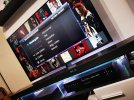Hello,
I am totally new to Linux. I have a device (an ancient media center PC) that is based on Linux with a custom GUI and I have 2 questions:
1.) How can I view or copy those files that are on the hard disk? I can copy the whole thing bit by bit, but I cannot view the filesystem on Windows. It says "Format the drive?". How can I view the content of the drive like I can e.g. a FAT formatted card on Windows explorer? It seems not to be FAT or NTFS, the file system is UNKNOWN. I use Windows 10. Can I boot into some kind of Linux, or install a Linux filesystem, so I can view those files?
2.) Is it possible to run this OS on a new PC? It is a bit old and slow and how can I preserve or update this thing? I tried to install more RAM, it needs special RAM SIMMs with 8 ICs on it, but if you have a different amout of RAM ICs on the stick, it won't boot. I then doubled the RAM (from 256 to 512); but had no performence increase (but at least it booted). Then I tried to use a SSD instead of the HDD. It did boot, but it all crashed catastrophically after writing a file (copy from USB to SSD). It stuck and it booted again after that, but never worked again (it crashed on playing back any files). I went back to the HDD and now I am stuck on the HDD again. And I dont think those will last forerver, so what can I do to preserve it?
-> That is more a hardware question - but awsked in a different way: how can I run the software on a modern PC or emulator?
So it seems very picky and very special highly integrated, closed device and I am not an expert. Is there anyone I can ask or any professional who could maybe have a look at that. I just would want to know how is it done or maybe remove some limitations or whatever. For example, when I copy it bit by bit, the partition size is what it is. Maybe someone could make a bigger partition, or edit the partition table, to allow for bigger drives. Just basic things, but I cannot even access this.
Is there any chance of updating this, seeing what it does, getting this ported to faster hardware or anything basically would help me (maybe). I understand that it does not make sense, but I am just so stuck and I just would need some help. I guess it has or needs many special drivers for the display, remote, buttons, needs a specific RAM size or CPU etc. But I love the menu and all that.
Any help would be appreciated.
It is the coolest device I ever saw in my life.
Thanks for reading.
I am totally new to Linux. I have a device (an ancient media center PC) that is based on Linux with a custom GUI and I have 2 questions:
1.) How can I view or copy those files that are on the hard disk? I can copy the whole thing bit by bit, but I cannot view the filesystem on Windows. It says "Format the drive?". How can I view the content of the drive like I can e.g. a FAT formatted card on Windows explorer? It seems not to be FAT or NTFS, the file system is UNKNOWN. I use Windows 10. Can I boot into some kind of Linux, or install a Linux filesystem, so I can view those files?
2.) Is it possible to run this OS on a new PC? It is a bit old and slow and how can I preserve or update this thing? I tried to install more RAM, it needs special RAM SIMMs with 8 ICs on it, but if you have a different amout of RAM ICs on the stick, it won't boot. I then doubled the RAM (from 256 to 512); but had no performence increase (but at least it booted). Then I tried to use a SSD instead of the HDD. It did boot, but it all crashed catastrophically after writing a file (copy from USB to SSD). It stuck and it booted again after that, but never worked again (it crashed on playing back any files). I went back to the HDD and now I am stuck on the HDD again. And I dont think those will last forerver, so what can I do to preserve it?
-> That is more a hardware question - but awsked in a different way: how can I run the software on a modern PC or emulator?
So it seems very picky and very special highly integrated, closed device and I am not an expert. Is there anyone I can ask or any professional who could maybe have a look at that. I just would want to know how is it done or maybe remove some limitations or whatever. For example, when I copy it bit by bit, the partition size is what it is. Maybe someone could make a bigger partition, or edit the partition table, to allow for bigger drives. Just basic things, but I cannot even access this.
Is there any chance of updating this, seeing what it does, getting this ported to faster hardware or anything basically would help me (maybe). I understand that it does not make sense, but I am just so stuck and I just would need some help. I guess it has or needs many special drivers for the display, remote, buttons, needs a specific RAM size or CPU etc. But I love the menu and all that.
Any help would be appreciated.
It is the coolest device I ever saw in my life.
Thanks for reading.




